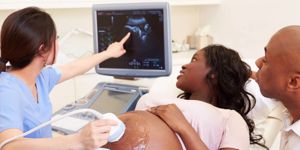This detailed ultrasound scan, sometimes called the mid-pregnancy or anomaly scan, is usually carried out when you're between 18 and 21 weeks pregnant.
The 20-week scan is offered to everybody, but you do not have to have it if you do not want to. The scan checks the physical development of your baby, although it cannot pick up every condition.
The 20-week scan is carried out in the same way as the 12-week scan. It produces a 2-dimensional (2-D) black and white image that gives only a side view of the baby. The NHS screening programme doesn't use 3-D or colour images.
If you want to know your baby's sex, you should ask the sonographer at the start of the scan, so they know that they need to check. Some hospitals may refuse to tell you sex of the baby. Speak to your sonographer or midwife to find out more.
The 20-week scan looks in detail at the baby's bones, heart, brain, spinal cord, face, kidneys and abdomen. It allows the sonographer to look for 11 rare conditions. The scan only looks for these conditions and cannot find everything that might be wrong.
You can find more information on each of these conditions, including treatment options, in these leaflets:
- Anencephaly
- Open spina bifida
- Cleft lip
- Diaphragmatic hernia
- Gastroschisis
- Exomphalos
- Serious cardiac abnormalities
- Bilateral renal agenesis
- Lethal skeletal dysplasia
- Edwards' syndrome, or T18
- Patau's syndrome, or T13
In most cases, the scan will show that the baby appears to be developing as expected, but sometimes the sonographer will find or suspect something different.
Your Baby Club and Center Parcs are giving you a chance to win a family break in a Woodland Lodge at a UK Center Parcs village of your choice.
Some conditions can be seen more clearly than others. For example, some babies have a condition called open spina bifida, which affects the spinal cord. This can usually be seen clearly on a scan and will be detected in around 9 out of 10 babies who have spina bifida.
Some other conditions, such as heart defects, are more difficult to see. The scan will find about half (5 out of 10) of babies who have heart defects.
Some of the conditions that can be seen on the scan, such as cleft lip, will mean the baby may need treatment or surgery after they're born.
In a small number of cases, some very serious conditions are found – for example, the baby's brain, kidneys, internal organs or bones may not have developed properly.
If any condition is found or suspected, the sonographer may ask for another member of staff to look at the scan and give a second opinion. Scans cannot find all conditions, and there's always a chance that a baby may be born with a health issue that scans could not have seen.






